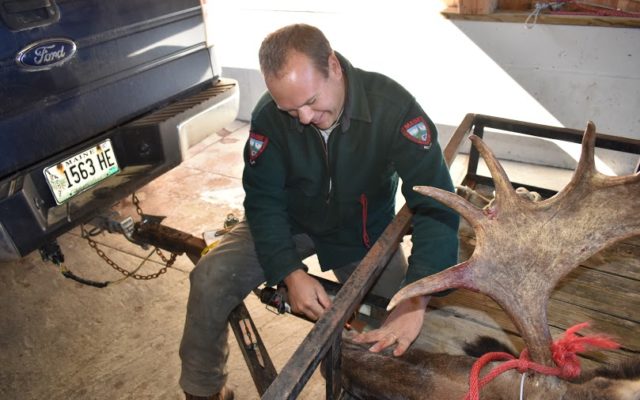
How to avoid making common moose-hunting mistakes
The old adage of moose-hunting holds that once a hunter pulls the trigger, all the fun is over. That’s because in many cases, actually extracting the moose from the woods can present any number of challenges.
But it doesn’t have to be that way. The state’s moose biologist, Lee Kantar of the Maine Department of Inland Fisheries and Wildlife, has offered a few tips for both before and after the shot is fired. Follow his advice, and you’re sure to face fewer pitfalls on your own hunt.
Whole or quartered? Make up your mind early.
“You’d think everyone would have made the decision conscientiously, that they’re either going to quarter the moose in the field or take it out whole,” Kantar said.
Unfortunately, that’s not the case. Luckily, the state has videos that show hunters exactly how to use either method. Field-dressing, often referred to as “gutting out” an animal, can be dirty work. Quartering, or removing the hide and cutting a moose into four pieces that can be more easily transported, can be a mystery to some. A little homework ahead of time can make all the difference.
Talk to a butcher before you head afield.
“It’s amazing when you’re at a moose check station and people don’t have lined up where they’re going to take the moose to be butchered,” Kantar said. “People need to number one, plan ahead for the fact that they are going to get a moose … they need to have a meat cutter already lined up.”
Many top meat cutters book their whole season ahead of time; arriving at a butcher with a moose on a trailer, only to find out that they’re not accepting any more work, can be a drag. And the next butcher might be miles away … if you can find one.
Book ahead.
Remember that crucial piece of paper.
On many of our hunting and fishing trips, we’re allowed to have a digital representation of our license, which will suffice if we need to show it to a warden. On a moose hunt, the rules are more specific.
“You need to make sure that you have your actual physical [moose-hunting] permit on you,” Kantar said.
Know where your second gun is.
With two hunters allowed to carry weapons and fire at a moose, it’s important that the permit-holder and the subpermittee not split up in order to find their moose.
The farther apart the two people are, the more apt they are to make mistakes in identifying or shooting a moose. In cases like that, double kills become a real possibility, as each hunter sees what they assume is the same moose the other was shooting at, and takes aim — thereby putting themselves over the moose limit. There’s a simple way to make that less likely.
“You need to make sure that when you’re hunting, your subpermittee is there with you, hunting within earshot to avoid any potential mistakes or poor outcomes,” Kantar said.
Watch the weather.
If it’s going to be warm, you should know that already. And if there’s rain in the forecast, you ought to know that, too. The weather can play a role in any hunt, and it doesn’t have to be a mystery.
“You should have a pretty good idea of what the weather’s going to look like, at least temperature-wise,” Kantar said.
And that kind of information may help hunters decide whether they want to avoid meat spoilage by quartering up a moose on a warm day.
Use ice. Better yet, remove the hide.
“The bottom line is, it’s the temperature of the meat that matters,” Kantar said. “Even if it feels cool outside, that’s not the temperature of the meat.”
The inside of a moose is about 100 degrees, you see. And meat starts to spoil when it’s above 40 degrees. Getting the carcass on ice as soon as possible is crucial. Even better, he said, is removing the hide and (you might have heard this already) quartering the moose, which allows them to cool down faster.